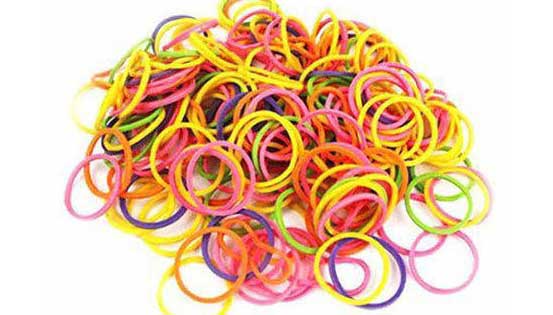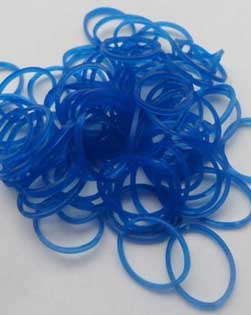26 October 2010- Synthetic Rubber is
man made rubber. It is term used for macromolecular substances of
natural rubber or rubber created
artificially. This is basically a crumbly, white, plastic mass which can be
processed and vulcanized in the same method as natural rubber.
There are different types of synthetic rubber, on the basis of their
application and mechanical and chemical properties. In the market today,
synthetic rubber is sold as compressed bales and square blocks and also in
the form of talcum-coated chips, powder rubber, granules and as latex
concentrates in liquid form. This type of rubber is better than natural
rubber as it has better oil and temperature resistance.


Types and Uses of Synthetic Rubber
- Styrene butadiene rubber (SBR): General purpose rubber having better abrasion resistance, poorer low-temperature behavior, lower elasticity, better aging and heat resistance, excellent electrical insulation material. Used in tire industry, conveyor belts, seals, technical rubber products
- Polybutadiene rubber (BR): This rubber is not used on its own. It is combined with SBR or NR. It is flexible at low temperatures and has got good elasticity. Used in tires, clutches, engine bearings, conveyor belts, technical products, drinking water seals .
- Isoprene rubber (IR): It is a more uniform, cleaner, transparent rubber. Used in technical products, like construction sections, heating hoses, cooling hoses for vehicles, high-performance tires, foodstuffs utensils
- Acrylonitrile butadiene rubber (NBR): This rubber has fuel and oil resistant, good temperature properties, and abrasion resistant. Used in motor vehicle parts, oil hoses, technical products, mats, plates, seals, rollers, and for foodstuffs like milk.
- Chloroprene rubber (CR): It is resistant to grease, flame retardant, and also resistant to oil, aging, abrasion and weathering. Used in conveyor belts, drive belts, clutches, all types of technical products, cables, pneumatic suspension systems.
- Butyl rubber (IIR) : This rubber is resistant to aging, ozone and chemicals. It has good mechanical and insulation properties. It has low permeability to gases and abrasion resistant. Used in automotive hoses, seals, membranes, tire inner liners, rubberized fabrics, hoses, cable insulation.
Storage of Synthetic Rubber
Synthetic rubber must be stored dry. Some type of synthetic rubbers must be stored cool and they have to avoid direct sunlight. Recommended storage duration for synthetic rubber is 5 years, though it can be extended to another 2 years.Packaging of Synthetic Rubber
The synthetic rubber bales are packed in plastic or polyethylene sheeting or in boxes lined with polyethylene. Powdered synthetic rubbers are packed in cardboard boxes or paper sacks lined with polyethylene and palletized. Flexible bulk packages can also be used. Synthetic rubber in granules is packed in polyethylene sacks and palletized. Here also flexible bulk packages can be used. Synthetic RubberMeans of transport
For general cargo, ship, truck, railroad is used. For liquid rubber, container transport is used. Insulated containers or open-sided containers are used which can protect the rubber from solar radiation and temperature variations.- Anti Vibration Mountings
- Automobile Rubber Products
- Calendered Rubber Products
- Extruded Rubber Products
- Medical Rubber Products
- Metal Bonded Components
- Rubber Adhesives & Sealants
- Rubber Ball
- Rubber Bands
- Rubber Beading
- Rubber Bearing
- Rubber Belt
- Rubber Buckets
- Rubber Bullets
- Rubber Cable
- Rubber Coating
- Rubber Duct
- Rubber Expansion Joints
- Rubber Flooring/Matting
- Rubber Footwear
- Rubber Gloves
- Rubber Injection Parts
- Rubber Lining
- Rubber Magnets
- Rubber Molded Products
- Rubber Pads
- Rubber Rollers
- Rubber Stopper
- Rubber Suit
- Rubber Track
- Rubber Valve
- Rubber Balloon
- Rubber Stamps
- Rubber Fenders
- Acrylic Rubber (ACM)
- Butadiene Rubber (BR)
- Butyl Rubber (IIR)
- Chlorosulfonated Polyethylene(CSM)/ Hypalon
- Ethylene Propylene Diene Monomer
- Fluoroelastomers (FKM)/Viton
- Isoprene Rubber (IR)
- Nitrile Rubber (NBR)
- Perfluoroelastomer (FFKM)
- Polychloroprene (CR)/Neoprene
- Polysulfide Rubber (PSR)
- Silicone Rubber (SiR)
- Styrene Butadiene Rubber
How to Make a Custom Rubber Stamp?
Whenever designing a custom stamp for your company, never compromise on its quality because in the end it is the most...
Read MoreLatex and Silicone Rubber Tubing - A Comparison!
Many industries use rubber tubing for various purposes. In fact, various types of rubber tubing are used for different applications...
Read MoreSilicone vs Acrylic Adhesive- A Comparison
Silicon and acrylic adhesives are those rubber adhesives that are widely used in Polyimide tapes. In fact, the polyimide...
Read More

